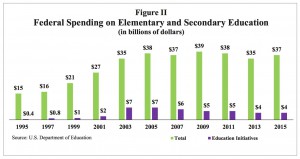
No. 186
Monday, January 25, 2016
by Lloyd Bentsen IV
[Excerpts from Issue Brief, full text on pdf here]
Over the years, federal funding of primary and secondary education has increased, while students’ academic performance has flatlined. For instance, the high school reading and math scores on the National Assessment of Education Progress show that student performance has remained flat for the past 20 years …
Federal Education Funding
Federal education funding comes in several forms. While most federal funds go to the states (a total of $37 billion in 2015) for K-12 school districts, $4 billion is devoted to special projects such as educational reforms through initiatives.1 Though federal money is only 11 percent of total spending on public schools, it comes with a host of strings attached.2
Federal spending on elementary and secondary education more than doubled from 1995 to 2003, with a large increase in funding for initiatives such as No Child Left Behind in 2003 [see Figure II]:
- Federal funding for elementary and secondary education more than doubled from $15 billion in 1995 to $35 billion in 2003, and education initiative funding more than doubled from $2 billion in 2001 to $7 billion in 2003.
- Total federal education funding increased from $42 billion a year in 2001 to $63 billion in 2003.3
- Education initiative spending peaked at 20 percent of total federal spending on elementary and secondary education and dropped to 10 percent by 2015.
Both overall funding for elementary and secondary education, as well as spending on education initiatives, began to drop after 2005 due to factors such as the Great Recession of 2007.
Four Federal Initiatives
The four most recent federal education reform initiatives include “Goals 2000′′ of the Clinton administration, “No Child Left Behind” of the Bush administration, and “Race to the Top” and “Common Core” of the Obama administration.
Goals 2000. Though Goals 2000 was presented to the states as a program in which they could “voluntarily” participate, opting out meant passing up states lost ground on a couple of goals, including teacher quality and school safety. The program was scrapped by Congress and essentially replaced by No Child Left Behind (NCLB).5
No Child Left Behind. The 2002 reauthorization of the Elementary and Secondary Education Act of 1965, No Child Left Behind, expanded the federal role in public education through further emphasis on annual testing, annual academic progress, report cards and teacher qualifications as well as signi cant increases in funding. …
No Child Left Behind’s reliance on one-size- ts-all testing, labeling and sanctioning schools undermined many education reform efforts. As a result, many schools, particularly those serving low-income students, have become little more than test-preparation programs.
Race to the Top. The federal government has offered grants through Race to the Top (RTTT) or so-called Flexibility Waivers under NCLB, School Improvement Grants and various other programs to push states, districts and schools to line up behind policies that use these same test scores in high-stakes evaluations of teachers and principals, in addition to the NCLB focus on schools.7 …
Common Core’s relationship with the federal government is a result of President Obama’s Race to the Top initiative.10
Common Core. Common Core math and English standards were released in 2010 and implemented by many states in 2014. However, of the states that adopted and have been implementing the standards, 14 are downgrading their participation or withdrawing from national tests designed around the standards. …
Conclusion
Federal education reforms have failed to achieve their goals and failed to have a positive impact on education performance. Perhaps their failure was due to lack of funding or poor execution, but the fact remains that these excuses are made over and over again on both the federal and state level without signi cant improvement. Despite the federal government’s valiant attempts, a universal national curriculum leaves too many students behind. …
For notes and references see full Issue Brief pdf, which includes additional analysis.
NCPA page with “Four Failed Federal Education Reforms” intro • Four-page Issue Brief PDF here.


